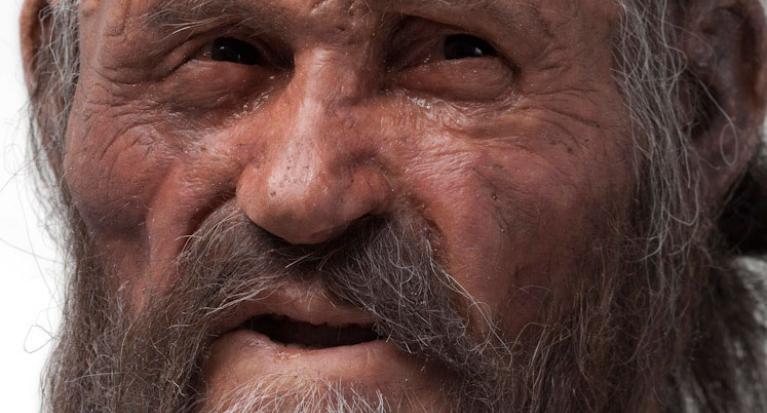The perfect meal in a pill?
Science fiction’s drab menus are pure fantasy!
Image 1. Virgil Finlay pour le pulp magazine If Worlds of Science Fiction, mai 1960.
© Maison d'Ailleurs, Yverdon-les-Bains
Science fiction does not attempt to anticipate the future: it is a narrative genre that acts like a magnifying glass to enlarge blueprints of the future that feed into the present. Indeed, since the Second Industrial Revolution of the 19th century generated a host of techno-scientific discourses and images suggesting what the future might have in store, many writers, engravers and illustrators have seized on these visions so as to conceive how things might turn out if they became reality – and this marked the birth of science fiction. That being said, let us now come to the question of the futuristic image of food conveyed by science fiction.
Illustrations 1 and 2 show particularly clearly how the future is “instrumentalised” to evoke the direction in which a booming industrial society is headed: it is imagined that an automatic steam machine will, a century later, in the year 2000, make it possible to accelerate the hatching of chicken eggs. Although, obviously, this picture is not really about the future – otherwise why portray women dressed the same way as in the 19th century? Rather, it is about the necessity to perfect a food industry that, in a flourishing society, must feed an ever greater number, and do so ever more quickly. A society’s wealth is evidently measured by how well it brings progress to its poorest locations. This picture serves, above all, to show the importance of seeing rural poverty, transformed by technology, adapt to an industrial society full of hopes and dreams.
A few decades later, the iconography dealing with these hopes and dreams clearly has a futuristic air, devoid of all naivety: Illustration 3 and especially Illustration 4 show not just the addition of a machine to a more or less pre-industrial countryside, but the complete metamorphosis of our way of cultivating – and therefore of seeing – the land. Illustration 4 depicts “A mechanical behemoth”, a factory that integrates a wide range of tasks, from harvesting to packaging! Here, the farm world becomes the place that nourishes Western humanity; as for the farmers themselves, they adopt the status of technicians, cut off from the land and their poverty; they physically become part of the machine. These science fiction images all underscore one of the fundamental aspects of food that is considered futuristic: foodstuffs have to be optimally produced using the efficient technology so highly praised since the Enlightenment. In this sense – and this is fundamental in understanding how science fiction uses the blueprints of the future to supply the empirical world – the food of the future will be industrial, not unlike that at the turn of the 20th century, that is to say, a production profoundly standardised for greater profitability. Food optimised for a population to be optimised: capitalist society seeks to evolve toward maximising profit, and the futuristic image of food merely reflects in a detached way the evolution already germinating in the modern world.
Metaphors for our hopes
For each of these images, science fiction puts forward a great many critical representations that challenge their ingenuity. This is the second function of the science fiction works mentioned at the beginning of this text: writers or illustrators seek to create metaphors – and some people wrongly take them at face value – so as to reflect on our hopes and dreams. Food is a topic often returned to since, as a central symbolic motif, it is where the meaning of human existence in an ever more capitalist world plays out.
Engraved by Hesketh Daubeny, Illustration 5, for example, graphically resembles Illustration 1. This time, however, irony is used in portraying the mass production of chicks: the peasant resembles more a pitiful fellow reduced to slavishly performing a repetitive task (placing the eggs in the machine), which leads to a chaotic invasion of chickens in his sorry-looking field. The optimisation of production and of capitalist wealth irremediably presupposes the alienation and poverty of the peasantry: it is also on this point that Illustration 6 seems to insist on presenting a full course meal as a sort of mise en abyme of the capitalist process itself.
In this last illustration, as to a certain degree in Illustration 7, people become cogs in a machine, a sort of fairground attraction for feeding: humans must be efficiently fed in order to contribute to the system that nourishes them, namely, the industrial system itself. Meals therefore become an automated process, during which everyone eats the same thing, in the same order, and nobody speaks to anyone else or laughs. When done, they move on towards the exit and back to work.
Also Illustration 8 suggests that the food of the future is no longer associated with pleasure or wealth, but the mechanical absorption of nutritive substances (there is a division of dishes in Illustration 7 and of components in Illustration 8). Joy or conviviality have disappeared, and only efficiency matters to these modern individuals who, dressed in uniform, have become the standardised elements of an efficient system: the food of the future takes on the same attributes as the society that manufactures them.
The final step is taken in Illustration 9: the astronaut of the future gulps down pills, food that is optimised, efficient and reduced to its bare nutritive components. But the character looks less than thrilled about this state of affairs: his pensive pout, along with the posters and pictures in his cockpit imply that nothing will replace a good chicken dinner or a juicy steak (a picture of which half covers a pin-up: the association between the “carnal” aspects of eating and sensuality is clear), despite the objective virtues of the pills.
Science fiction illustrators were not fooled: the progress vaunted by certain techno-scientific discourses appears to them to be cruelly lacking in substance (the astronaut’s plate is after all empty) and that is something of an understatement, since the metaphor of “substance” leads us to decode the real symbolism of efficient food. This symbolism is taken to its extreme in the French poster of the film Soylent Green (1973) in Illustration 10. In 2022, the world is overpopulated, poverty is on the rise, nature is moribund, and the people feed on Soylent Green – a high-energy synthetic food produced by a multinational. We learn through a final narrative twist that this product is in fact manufactured using human corpses: we have come full circle, humankind feeds on its own flesh, it has become the consumer product that is given to individuals so that they keep consumer society going.
Tell me what you eat, and I will tell you what you are
The metaphor of Soylent Green expresses nothing other than the process discussed at the start of this article: to talk about the food of the future is to talk about a society that is seeking to optimise its system of production. First, the mass production of chicks and produce from the earth, then the functionalisation of meals for the sake of efficiency, and, finally, humans who become sustenance for other humans: hence, science fiction does not reflect on the actual evolution of the foods we consume, but reminds us that our conception of food reveals, above all, something about our conception of human beings. In other words, the food of the future will be similar to the humans of the future. The more we standardise our foodstuffs, the clearer it becomes that humankind will also be standardised; the more we break down our meals into individual components or make them artificial, the more we will surely be broken down ourselves (into components detached from a system we cannot fathom) and made artificial (turned into a social function in which our inner selves matter little). In a nutshell: “Tell me what you eat, and I will tell you what you are.”
DOSSIER Trends and Turns |
| Canned food – an instrument of power | |
| The rise of the Mediterranean diet | |
| Ötzi and his diet | |
| Too much or not enough? | |
| It may look good, but is it? | |
| The perfect meal in a pill? | |
| All dossiers | |
Food of the future and futuristic images of food – what’s the difference?
Contrary to appearances and stereotyped opinions, science fiction does not anticipate – and, consequently, in no way predicts – the future of our (post-)industrial civilisation. Certainly, it proposes fictional universes and paints them in futuristic colours, but for the most part these merely present, in an offbeat or detached way, motifs that are actually already an integral part of our daily life.
The distinction between the “food of the future” and “futuristic images of food” may appear minute, but it is, in fact, considerable. If representations in science fiction do indeed suggest an evolution in our modes of food consumption, they do so, firstly, to underscore the fact that this evolution has beneath the surface already taken place on an empirical level.
And, secondly, to form a – more or less original – metaphor that serves to contemplate the transformation of the human condition in the era of the development of science, technology and the capitalist world.
A future to make your mouth water
The food of the future will be the fruit of a compromise between authenticity and economic necessity.
What will be on our plates in the future? Our plates will reflect the fact that, by 2050, there...




